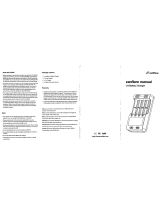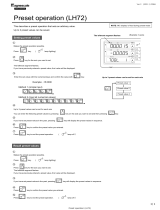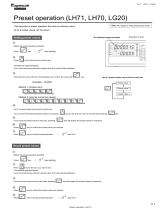Page is loading ...

ToxiRAE
POCKET PID
PGM-30
OPERATION AND MAINTENANCE
MANUAL
(Document No.: 007-4001-004)
Rev. E
RAE SYSTEMS INC.
3775 N. First St.
San Jose, CA 95134-1708
May 2005

RAE Systems Product Line
Gas Detection Tubes & Pumps
SampleRAE Electronic Tube Pumps
D-RAE Combustible/O
2
/H
2
S/CO Monitors
AreaRAE Wireless Multi-gas Monitors
MultiRAE PLUS Multi-gas Monitors
Q-RAE Confined Space Monitors
VRAE Five Gas Surveyors
MiniRAE 2000 Portable VOC Monitor
ppbRAE Parts Per Billion Monitors
UltraRAE Specific Compound Monitors
ToxiRAE PLUS PID Monitors
ToxiRAE PLUS Single Gas Monitors
ToxiRAE PLUS Oxygen Monitors
ToxiRAE PLUS Combustible Monitors
ModuRAE Fixed System PID
MiniRAE PLUS Classic Monitor
How can I be informed and updated?
Be sure to mail in your warranty card via email, post or fax
to get on RAE’s private database (information is never
supplied to others).
You will be updated on new products, technical advisory
notices, new accessories and much more. Thank you for
your purchase!

IMPORTANT!
Note: RAE Systems’ updated firmware version V1.30
and above for the ToxiRAE PID (PGM-30)
requires the new lamp so when ordering
replacement lamps please use part #050-0040-000.
The ToxiRAE PID (PGM-30) with firmware
version V1.27 and below requires the standard
lamp, please use part #050-0010-000 when
ordering replacement lamps.
Thank you.
RAE Systems

i
Table of Contents
1. GENERAL INFORMATION............................................ 1-1
1.1 General Specifications.....................................................1-2
2. OPERATION OF TOXIRAE............................................ 2-1
2.1 Physical Description........................................................2-2
2.2 Keys and Display.............................................................2-4
2.3 Power On/Off...................................................................2-6
2.4 Operations........................................................................2-8
2.5 Alarm Signals ................................................................2-11
2.6 Backlight........................................................................2-14
2.7 Preset Alarm Limits and Calibration.............................2-15
2.8 Datalogging....................................................................2-16
3. OPERATION OF CHARGING STATION .................... 3-1
4. PROGRAMMING OF TOXIRAE................................... 4-1
4.1 Menu Options ..................................................................4-2
4.2 Keys for Programming Mode..........................................4-4
4.3 Entering into Programming Mode...................................4-5
4.4 Calibration of ToxiRAE Unit ..........................................4-7
4.4.1 Zero Gas Calibration .................................................4-8
4.4.2 Standard Reference Gas (Span Gas) Calibration.....4-10
4.4.3 Standard Reference Gas (Span Gas) Check.............4-12
4.4.4 Enter Standard Calibration Gas Value.....................4-14
4.5 Set Alarm Limits............................................................4-16
4.5.1 Set TWA Alarm Limit.............................................4-17
4.5.2 Set STEL Alarm Limit ............................................4-18
4.5.3 Set Low Alarm Limit...............................................4-19
4.5.4 Set High Alarm Limit..............................................4-20
4.6 Set Datalog Options.......................................................4-21
4.6.1 Clear Data Memory .................................................4-22
4.6.2 Set Datalogging Period............................................4-23
4.7 Set Real Time Clock......................................................4-24
4.7.1 Set Year ...................................................................4-25
4.7.2 Set Month ................................................................4-26
4.7.3 Set Day ....................................................................4-27
4.7.4 Set Hour...................................................................4-28
4.7.5 Set Minute................................................................4-29
4.8 Gas Correction Factor....................................................4-30
4.8.1 Select Gas................................................................4-31
4.8.2 Modify Correction Factor........................................4-32

ii
4.9 Setup Instrument............................................................4-33
4.9.1 Set User ID ..............................................................4-34
4.9.2 Set Site Number.......................................................4-35
4.10 Exit Programming Mode ...............................................4-36
5. COMPUTER INTERFACE FOR ToxiRAE.................... 5-1
5.1 Install ProRAE-Suite Software........................................5-2
5.2 Connect ToxiRAE to PC .................................................5-4
5.3 Start ProRAE-Suite Software ..........................................5-5
5.4 Setup Communication Port..............................................5-7
5.5 Processing the Configuration Data..................................5-8
5.5.1 Editing the Configuration Data..................................5-9
5.5.2 Send Configuration to the ToxiRAE .......................5-17
5.5.3 Receiving Configuration Data.................................5-18
5.5.4 Configuring All Settings..........................................5-19
5.6 Processing the Logged Data ..........................................5-20
5.6.1 Receiving Data ........................................................5-21
5.6.2 View Logged Data in Text Mode............................5-22
5.6.3 View STEL/TWA/AVG Value................................5-24
5.6.4 View Summary Information....................................5-25
5.6.5 View Logged Data in Graph Mode .........................5-26
5.6.6 Export the Displayed Data to a Text File ................5-30
5.6.7 Exporting Graph to a File........................................5-31
5.6.8 Print the Logged Data..............................................5-32
5.6.9 Upgrade the Datalog Option....................................5-33
6. THEORY OF OPERATION ............................................. 6-1
7. MAINTENANCE................................................................ 7-1
7.1 Battery Charging and Replacement.................................7-2
7.2 Sensor Module Cleaning..................................................7-5
7.3 Lamp Cleaning and Replacement....................................7-7
8. TROUBLESHOOTING..................................................... 8-1
8.1 Special Diagnostic Mode.................................................8-1
8.2 Troubleshooting Table.....................................................8-3
APPENDIX A. REFERENCE OF DISPLAY MODE……..A-1
APPENDIX B. REFERENCE OF PROGRAM MODE…...B-1
APPENDIX C. RESPONSE INFORMATION………….….C-1
APPENDIX D. RAE SYSTEMS TECHNICAL NOTES…..D-1
APPENDIX E. RAE SYSTEMS APPLICATION NOTES..E-1
Main Contact Numbers...………………...…Outer Back Cover

iii
WARNING
-DO NOT PROCEED WITHOUT READING-
THIS MANUAL MUST BE CAREFULLY READ BY
ALL INDIVIDUALS WHO HAVE OR WILL HAVE
THE RESPONSIBILITY FOR USING,
MAINTAINING, OR SERVICING THIS PRODUCT.
The product will perform as designed only if it is used,
maintained, and serviced in accordance with the
manufacturer's instructions.
CAUTION!!
TO REDUCE THE RISK OF ELECTRIC SHOCK,
TURN OFF POWER BEFORE REMOVING THE
SENSOR CAP AND SENSOR MODULE FOR
SERVICE. NEVER OPERATE THE UNIT WHILE
THE CAP IS REMOVED. REMOVE SENSOR CAP
AND SENSOR MODULE ONLY IN AN AREA
KNOWN TO BE NON-HAZARDOUS.
TO REDUCE THE RISK OF IGNITION OF
HAZARDOUS ATMOSPHERES, RECHARGE
BATTERY ONLY IN AREA KNOWN TO BE NON
HAZARDOUS.

iv
CAUTION:
For safety reasons this equipment must be operated
and serviced by qualified personnel only. Read and
understand instruction manual completely before
operating or servicing.
ATTENTION:
Pour des raisons de sécurité, cet équipment doit être
utilisé, entretenu et réparé uniquement par un
personnel qualifié. Étudier le manuel d’instructions
en entier avant d’utiliser, d’entretenir ou de réparer
l’équipement.
WARNING:
Use only RAE Systems battery packs, part nos. 500-
0021 or 500-0022. This instrument has not been tested
in an explosive gas/air atmosphere having an oxygen
concentration greater than 21%. Substitution of
components may impair intrinsic safety. Recharge
batteries only in non-hazardous locations.
AVERTISSEMENT:
Utiliser seulement l'ensemble de batterie RAE
Systems, la reference 500-0021 au 500-0022. Cet
instrument n’a pas été essayé dans une atmosphère de
gaz/air explosive ayant une concentration d’oxygène
plus élevée que 21%. La substitution de composants
peut compromettre la sécurité intrinsique. Ne charger
les batteries que dans emplacements désignés non
dangereux
.

v
WARNING:
The calibration of all newly purchased RAE Systems
instruments should be tested by exposing the sensor(s)
to known concentration calibration gas before the
instrument is used or put into service.
For maximum safety, the accuracy of the ToxiRAE
should be checked by exposing the sensor(s) to known
concentration calibration gas before each day’s use.
AVERTISSEMENT:
La calibration de toute instruments de RAE Systems
doivent être testé en exposant l’instrument a une
concentration de gaz connue par une procédure
dietalonnage avant de mettre en service l’instrument
pour la première fois.
Pour une securite maximale, la sensibilité du
ToxiRAE doit être verifier en exposant l’instrument a
une concentration de gaz connue par une procédure
dietalonnage avant chaque utilisation journalière.

vi
Special Note
-1-
When the PGM-30 Pocket PID is taken out from the
transport case and turned on for the first time, there
may be some residual organic vapor trapped inside the
ionization chamber. The initial reading may indicate a
few ppm. Enter an area known to be free of any
organic vapor and turn on the unit. After running for
several minutes, the residual vapor in the sensor
chamber will be cleared and the reading should return
to zero.
-2-
The battery of the ToxiRAE unit will discharge slowly
even if it is turned off. If the unit has not been charged
for 5-7 days, the battery voltage will be low. Therefore,
it is a good practice to always leave the unit in the
charger so that it is fully charged and ready for
immediate use. It is also recommended to fully charge
the unit FOR AT LEAST 4 HOURS before first use
(see Section 3.0 for more information).

GENERAL INFORMATION
1 - 1
1. GENERAL INFORMATION
ToxiRAE is a programmable pocket Photo-Ionization
Detector (PID) designed to provide continuous exposure
monitoring of toxic gases for workers in hazardous
environments. It monitors two classes of toxic gases: (1)
organic vapors with the supplied 10.6 eV gas discharge
lamp, and (2) chlorinated compounds with the
interchangeable 11.7 eV lamp available as an optional
accessory. Features are:
Lightweight and Compact
-6.4 oz, pocket size
Dependable and Accurate
-12 hours monitoring with micro controller
User Friendly
-menu driven, intuitive end-use operation
Programmable Alarm Thresholds
-audio buzzer & flashing display alarm
ToxiRAE (PGM-30K) consists of: A Pocket PID unit, a
single station charging unit, plus calibration accessories.

GENERAL INFORMATION
1 - 2
1.1 General Specifications
Table 1.1
Pocket PID Unit Specification
Dimensions 6.0"L x 1.75"W x 1.0"H
Weight 6.4 oz with battery
Detector Electrodeless 10.6 eV ultraviolet
discharge lamp with Teflon stainless
steel chamber
Battery Rechargeable, 2.4V/900 mAh, Ni-CD
battery pack or alkaline battery
adapter
Operating Time 12 hours continuous operation
Attachment Belt/Pocket clip
Display 8 digit LCD with LED backlight
Range 0 to 99.0 ppm with 0.1 ppm resolution
100 to 2000 ppm with 1 ppm
resolution
Accuracy +/- 2 ppm or +/- 10% of reading
calibrated to 100 ppm isobutylene
Response Time <10 seconds to reach 90% point when
exposed to 100 ppm isobutylene
(continue)

GENERAL INFORMATION
1 - 3
Pocket PID Unit Specification
(continued)
Keypads 1 operation key and 2 programming
keys
Alarm Settings Separate alarm limit settings for
TWA, STEL, Low and High alarm
Alarm 90 dB buzzer and flashing red LED to
indicate exceeded preset limits, low
battery, or lamp failure
Calibration Two point field calibration for zero
gas and standard reference gas
Protection Password protected calibration
settings, alarm limits and data
Data Storage 4000 readings in non-volatile memory
(programmable period)
Temperature -10
o
to 40
o
C (14
o
to 104
o
F)
Humidity 0 to 95% relative humidity
(non-condensing)

GENERAL INFORMATION
1 - 4
Table 1.2
Single-unit Charging Station Specification
Dimension 2.5"L x 2"W x 3.5"H
Weight 4.1 oz.
Charging Capacity 1 slot to charge a ToxiRAE Pocket
PID plus 1 auxiliary connector to
charge a spare Ni-Cd battery pack
Power Source 110VAC or 6V DC
Charging Time 4 hours to full charge
Charge Status Three-color LED to indicate charging
(red), ready (green), discharge
(amber) and not charging (off)
Safety Control Two step constant voltage / constant
current charging to prevent
overcharging

OPERATION OF TOXIRAE
2 - 1
2. OPERATION OF TOXIRAE
The ToxiRAE PID Unit is a pocket size organic vapor
exposure monitor/sampler. It gives the real time
measurements and activates alarm signals whenever the
exposure exceeds preset limits. Prior to factory shipment
the ToxiRAE is preset with default alarm limits and the
sensor is pre-calibrated with 100 ppm isobutylene gas.
However, the user should calibrate the instrument before
the first use. After the unit is fully charged and calibrated,
it is ready for immediate operation.

OPERATION OF TOXIRAE
2 - 2
2.1 Physical Description
Figure 2.1 shows the main components of the ToxiRAE
Pocket PID Unit which includes:
3 keys for user to interact with the unit: 1 operation
key and 2 programming keys for normal operation
or programming of the unit
LCD display with back light to show real time and
calculated measurements
Buzzer and red LED for alarm signal whenever the
exposures exceed preset limits
Clip for attachment to the user's pocket, lapel or belt
Battery contact for plugging directly to the charging
station
Gas entry port sensor cap
Infrared communication port for PC interface
(optional)

OPERATION OF TOXIRAE
2 - 3
Figure 2.1 Major Parts of the ToxiRAE
Pocket PID Unit

OPERATION OF TOXIRAE
2 - 4
2.2 Keys and Display
Figure 2.2 shows the LCD display and the keypad on the
front panel of the unit. The function of the 3 keys during
normal operation are summarized below:
Figure 2.2 Key-pad and Display of the ToxiRAE
Pocket PID Unit
Table 2.1
Key Function in Normal Operation
[MODE] -Turn on/off the power* and choose
different display mode
[N/-] -Toggle on/off the back light
[Y/+] -Alarm test and alarm acknowledge (turn off
latched alarm
* Pressing and holding [MODE] key for 5 seconds turns
off the power to the unit. Unit will beep once per second
during power-down sequence. Press [MODE] key
momentarily to choose different display modes (see
Section 2.4 for details).

OPERATION OF TOXIRAE
2 - 5
The Pocket PID includes an 8-digit dot matrix LCD
display. The LCD show the following eight types of
displays during normal operation:
Real time gas concentration in ppm
Time weighted average (TWA) value of the gas
concentration in ppm
Short term exposure level (STEL) of the gas
concentration in ppm
Peak gas concentration in ppm
Battery voltage in volts
Run time in hours and minutes
"Log On/Off?" menu to enable/disable datalogging,
(only in datalog version of PGM-30D)
"PC Comm?" menu to send or receive data between
PC and the ToxiRAE unit

OPERATION OF TOXIRAE
2 - 6
2.3 Power On/Off
To turn on the ToxiRAE Pocket PID Unit, press
[MODE] key. The audio buzzer will beep once and the
display show "ON!.." and then "Ver n.nn" to indicate the
software version number. The serial number of the unit is
displayed next. The unit will then go through a self-
diagnostic routine to check the key components of the unit.
A "Diagnose" message is displayed with red backlight
turned on while the self-diagnostic routine is executing.
The red LED will flash once and the buzzer will beep once
to ensure that they are functional.
The unit next displays the four preset alarm limits, battery
voltage and available data storage memory (in percentage).
After about 20 seconds, the display shows the
instantaneous reading of the gas concentration in ppm and
is ready to monitor gas concentration.
To turn off the ToxiRAE Pocket PID Unit, press and hold
the
[MODE] key for 5 seconds. Unit will beep once per
second during power-down sequence. The message
"Off!.." flashes on the LCD display and the display, goes
blank indicating that the unit is turned off. When the unit
is turned off, all the current real time data including TWA,
STEL, Peak and run time are erased. However, the datalog
data is preserved in non-volatile memory for data down
load at a later time. The current date and time of day are
also preserved, as long as the batteries have sufficient
charge.

OPERATION OF TOXIRAE
2 - 7
Datalog versus Non-Datalog unit
There are two versions of PGM-30 Pocket PID: Datalog
unit and Non-Datalog unit. During power on sequence, if
there is a letter “D” follows the version number indicates
that the unit is configured as a Datalog unit. Without the
letter “D,” it is a Non-Datalog unit.
User can upgrade a Non-Datalog unit to a Datalog unit.
Call factory for information on how to order the upgrade
kit and follow the instructions described in Section 5.13 to
enable or disable the datalog feature for the unit.
1/139



